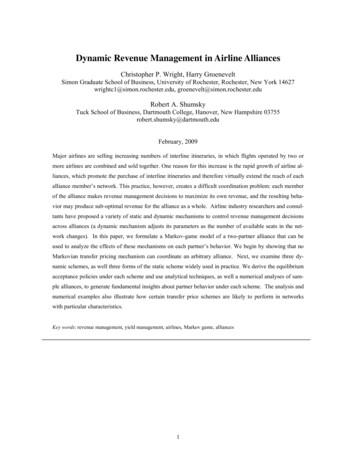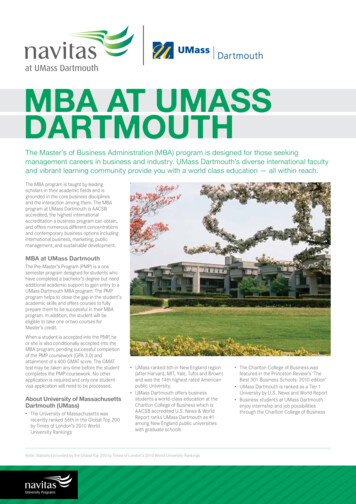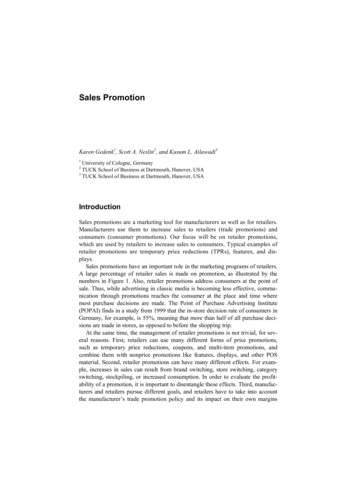
Transcription
WOODSmOkE
Dartmouth Outing Club2015 - 2016Outdoor Programs Office119 Robinson Hall6 N Main StHanover, NH 03755(603) 646-2428magazine designed by Regina Yan ‘19
.AND THE GRANITEOF NEW HAMPSHIREIN THEIR MUSCLESAND THEIR BRAINSCoNtentsFrom the Desk of the President2The Yosemite of South America 4Getting some Mud on my Boots6Life Lessons from Life stories8A WhiteWater Paradise 10highway hypnosis of the ocean16The power of Powder18Wood you make the cut?20From Skyscrapers to mountain peaks22Ruth Gorge(ous)24
From the Desk ofSCENES AROUND THE GREENthe PresidentAs the snowmelt leaves from an unusually warm winter, and as students return tocampus for their spring term, stories of adventures in the out-of-doors buzz around the DOC.The Dartmouth Outing Club ran a record 10break trips, spanning the continent from Quebec, to North Carolina, to the Grand Canyon.Students learned a lot from the dusty trails, thesnowy mountains, and the rushing rivers. Hundreds of students learned to build their confidence, work through group conflict, and openup emotionally with their peers. Dozens of student leaders gained important experience byguiding these trips. These experiences will last alifetime. Yet, while the DOC is active during ourschool breaks, it is only the tip of the iceberg.As the class of 2019 joins our ranks, theDOC grows to a record size, with over 2000members for the first time in its history. Yet, asa club we are continuing to strive to be better.The DOC has been actively reflecting on howwe can make our club a more inclusive place,and making sure we are welcoming to everyone who wants to join. A generous grant fromthe President’s office has allowed us to providefinancial aid for all outdoors activities meaningthat money is never an obstacle to people getting outside. These efforts are paying off. Theweekly dinner feeds that each sub-club has arefilled with lively chatter, and Robinson Hall isbustling with students preparing for trips, doing homework, and planning new adventures.The DOC continues to be a leader on campus, epitomizing experiential education, leadership development opportunities, and a healthycommunity space. Trip participants learn everything from knot tying to self-determination. Aspiring leaders gain experience organizing trips, andmanaging a group. And contra-dances, lodge dinners, and paintballing trips prove that social eventscan be fun, healthy, and accessible to everyone.As the club grows, we welcome a newstaff member to our Outdoor Programs Office. Morgan Haas joined us and has brought afresh energy to mentoring students, and making the many processes we have in place moreefficient. In addition, we welcome a new subclub to our ranks. ‘Women in the Wilderness’ hasbeen re-founded as a way to encourage womenacross campus to get involved in the outdoors.As we move forward into the warm andsunny Hanover Summer, I am excited to watchstudents get outdoors through the DOC. Whether sleeping in a DOC Cabin, paddling on theConnecticut River, or hiking in the White Mountains, the outdoors continues to be a cornerstone of the Dartmouth experience for students,and I am excited to help this legacy continue. Ihope that the stories you are about to read inspire you, motivate you, and remind you abouthow special the outdoors and the DOC are.Yours in the Out-of-Doors,Alex Lochoff ‘17Dartmouth Outing Club President3
“I wouldn’t have it anyother way. The complete lackof crowds, the absence of a30-day camping limit, and theseemingly endless first ascentpotential make Cochamo trulyspecial.”the YosemiteThe Yosemite of South America. This unofficial motto for Cochamo Valley, a climbing area insouthern Chile, echoed in my head as I got ontothe plane at Logan. I had seen Yosemite for thefirst time this past summer, and I couldn’t fathom anything comparing to the perfectly clean,soaring granite cliffs that greet visitors entering“The Valley.” With limited international attention, very little online beta, and a much shorter history than the famed cliffs of Yosemite, Iwondered just what I would find in Cochamo.The idea for a Patagonia climbing trip firstcame to be almost a year earlier when I wasapplying for the Buenos Aires LSA. When elsein my life was I going to have a month longchunk of free time paired with an excuse to flyto Argentina? I bought the tickets, got in touchwith a strong climber and friend of many Dartmouth climbers, Jordan Moore, and agreed tomeet him in Bariloche on the first of December.When we met up, we decided it would bewise to start at an area just outside of Barilochecalled the Frey. We hoped that this area, a paradise of seemingly endless alpine spires, wouldhelp us prepare for the big walls of Cochamo.It is hard to do the Frey justice with words,but the best I’ve heard it described as if someone took the dribble castles that kids make onthe beach and transported them to a huge alpine cirque. In every direction, 100 500-footspires made of perfect alpine granite jut up,begging to be climbed. In five days of climbing we sampled quite a few of the spires, butby far my favorite was Torre Principal. Sittingdead center in the ridgeline and rising aboveall the surrounding mountains, Torre Principalis the obvious objective. The narrow summitoffered views for hundreds of miles around.After a successful week in the Frey, we decided we were ready for Cochamo Valley. Onelost sausage to a Chilean border control dogand one lost packet of cookies to a hostel owner’s dog later, we arrived in the small town ofCochamo with close to 100 kg of food and gear.With the help of a friendly supermarket owner,we managed to procure a horse to help carryfood in, and we started into the jungle. Thesupermarket owner, we managed to procure aOF SouTh aMeRicahorse to help carry food in, and we startedinto the jungle. The 10 km hike in sets thetone for Cochamo. Thick jungle and mud filledtrenches made for slow progress, and afterthe first few kilometers, I gave up trying tokeep my feet dry. After around four hours, wewere greeted with our first view of the cliffs.What a view it was. Simply put, Cochamois massive. A shorter Cochamo climb might be“only” 1,000 ft, and the largest wall, The Monster, has routes as long as 4,300 ft. Needless tosay, Jordan and I were definitely feeling rathersmall by the time we had set up base camp.Due to the length of approaches, we took thestandard approach of setting up an advancedcamp in one of the hanging valleys closer tothe climbs. Our first climb was Al Centro y Adentro, an amazing 1,500 ft 5.11 that a certainfamous soloist dubbed “The Astroman of SouthAmerica.” The climb had everything: techyslab, bombay off-width chimneying, and a perfect stemming dihedral pitch. Twelve pitches of pure heaven later, and we were treated to yet another amazing Patagonia vista.Over the next three weeks we took advantageof what good weather we got and completedfour more climbs, getting turned away twice ona fifth. In these weeks, we battled the rope troll(that pesky little guy who lives on the cliff andlikes to ties knots in your rope as you pull rappels), mastered tree-a-ferrata (the act of climbing vertical mud and bushes), and repeatedlyrediscovered just how much fun it is to bushwhack through jungle while wearing a haul bag.So just how does Cochamo compare toYosemite Valley? The approaches are justa little bit longer, the granite just a little bitdirtier. But I wouldn’t have it any other way.The complete lack of crowds, the absence ofa 30-day camping limit, and the seeminglyendless first ascent potential (seriously, theamount of untouched granite is absurd) makeCochamo truly special. For every ounce ofenergy I put into climbing at Cochamo, I wasrewarded with endless adventure, friendship,and yes, even the occasional splitter pitch. DAVID BAIN ‘175
Getting SomeTop: Benson poses with fellowtrip members in the MazatzalMountains.Bottom: The trip takes a breakfrom hiking to enjoy the ArizonasceneryMUD on my BootsI am an African American man from Florida. Icome from a family that doesn’t go on vacation,and if we did, the mountains would never be onour list of destinations. So when I was assigned toa Hiking 3 First Year Trip, I had no idea what I wasin for. I showed up on Robo lawn wearing bootsthat I had broken in at the beachfront store that Iworked in all summer. Neither the boots nor theirowner were ready for three days of intense hikingand their first 4000-footer. So after a trip that included rain, rock scrambles, stomach distress, andstressful descents, I shoved my boots in my closet and lied down to rest my sore feet, hips, andshoulders. The thought of ever hiking again wassuch a joke that when my trippee asked me to goa Cabin and Trail meeting, I laughed uproariouslybefore deciding to humor her with my attendance.Given my past experience, I cannot tell youwhat compelled me to apply for the Cabin andTrail winter break backpacking trip, nor can I tellyou what compelled them to accept me when inthe application I said my motivation for applyingwas “to get some mud on my boots.” Regardlessof the build-up, a few weeks later I found myself camping at the base of the Mazatzal Mountains, preparing myself for a seven-day trip thatwould be one of my first hiking experiences.The other members of my trip were impressive in their own right. One leader was a ’14 whohad taken a gap year to hike in Nepal, completedThe Fifty with ease, and was a Wilderness FirstResponder. He was partnered with a bold anddriven ’17, who talked about hiking in the Cascade Range near her house and didn’t even consider summiting the 7,000 foot Mazatzals to be achallenge. My trippees were no less impressive.An eloquent and intellectual ’15 who had just returned from hiking on an FSP in South Africa andseemed to have knowledge about every personand every facet of this trip. A brilliant engineer‘16 from Alaska who had hiked, skied, and conquered every outdoor challenge imaginable inAmerica’s Last Frontier. A passionate ’16 who wasabout to embark on a thrilling off-term in ruralPeru and was a leader on campus in every sphereshe touched. So when sunrise came to our campground and the morning sun touched on me, a’17 who was still mentally weary from the term andwas in no physical shape to even consider backpacking -- well, you could say that I was terrified.The next seven days were ones that I willcherish for the rest of my life. They were not easy,restive, or casual, but still days that I will cherish.I got to know the people on my trip better thanmost people at Dartmouth. When you are hiking,it is easy to get past the basic questions (whatis your major, where are you from, and how areyour classes). You soon get onto stories of discovering your sexuality, childhood gang violence,mental health, why Dartmouth may have beena mistake, why Dartmouth is the dream you andyour family never could have imagined possible,and the reason why you will never stop hiking.Things didn’t always go according to plan.Nights were way too cold and my stomach fartoo restless. We ended up evacuating a mountain range due to unexpected cold and snowvia a path covered in frozen waterfalls and cliffswith 500-foot drops. Ascents were challenging,food was new and different, and legs were weary.But regardless of any challenges, sights werebreathtaking, conversation was insightful, andhappiness came from simple and beautiful things.From this trip, I met my roommates for the nextyear and my new best friends. I found a community at Dartmouth, and I fell in love with hiking.One year later I am still hiking, still terrified, andstill just trying to get some mud on my boots. Jalen Benson ‘177
Life Lessonsfrom Life StoriesI closed my eyes, preparing myself for thestory that was about to unfold in front of mytrippees’ eyes. I knew two of them well, andI considered them to be close friends. Threeof them were barely acquaintances, people I said hi to on the street. The last I hadmet the day before and was only just learning how to correctly pronounce his name.But I was about to share my story, all 20years of it. As a self-identified cry-talker, I knewI would cry (I was right), but I was willing tobe vulnerable in front of these people, thoughI hardly knew most of them at all. I spoke foralmost an hour, highlighting several life moments, discussing my changing worldviews,and describing my family and loved ones.A camping light hung in the tent, so I couldmake out my trippees’ faces around me, butI avoided eye contact as I told them my story.Something about the Utah air made mewilling to reveal my life, thoughts, and feelings,despite having only spent a day with my companions. This was not surprising to me; as oneof the leaders of the trip, I had decided thatone way to improve our group dynamic and facilitate friendships was for each of us to take anhour or so to tell the story of our life. I went first,as I had done this activity before with a groupduring First Year Trips, and we heard two lifestories on the following three nights of the trip.These life stories allowed for each of us to talkopenly in a way that, while somewhat contrived,brought each of us to impart parts of ourselvesthat may not have come up in natural conversation. The nature of our trip allowed the conversations to continue into the next day, creatinga starting point that opened up discussions onthe trail that we might not have otherwise had.And it’s true that these stories ultimatelybrought us closer. Gathering seven people in a3.5-person tent in the cold, desert night to sitfor three hours truly can bring together a groupin ways I had not seen before. I’ve witnessedmany groups spend days and weeks togetherexploring the natural world, but I had not seensuch a diverse group connect as quickly as thisone. I suppose all we needed was a little understanding of one another to break throughphoto courtesy of Victoria Nelsonour differences and form true friendships.The wilderness always seems to providethe perfect setting for conversations like lifestories. Perhaps there is something about theopen air that makes open conversation seemso natural. I have spent the past nine years going on extended wilderness trips, and it is notuncommon to find myself forming tight knitrelationships over the course of a few daysthat would have taken weeks, months, andyears to establish in the frontcountry. Maybe it’s the proximity. Maybe it’s the endlesshours spent together, forced to find conversation to avoid losing myself in my own head.But I think it’s more than that. I believe thatextended tripping pushes us to find within ourselves our strongest sense of awareness, empa-thy, and compassion. It brings out the best in us.Without these traits, the proximity and endlesshours would become toxic. Instead, they becomerewarding, facilitating closer and more uniquefriendships than one could find anywhere else.Last winterim, I traveled to the Escalante National Monument in Utah with six diverse humanbeings. We came from different corners of campus, the country, and the world with stories thatgreatly contrasted one another. The DOC andC&T brought our narratives together for sevendays last December. And now, despite our differences, our stories will forever include each other. Victoria Nelson ‘179
“The trust cultivatedbetween companions onthe river isinvaluable andeverlasting, being,founded in amutual passion foradventure with anever-present awarenessof the inherent risks.”11
A WhitewaterParadiseThe Ledyard Canoe Club adventured to theNapo Province of Ecuador for two weeks of paddling this fall-winter interim. Esteban Castaño’14, and Jonathan King ’15, organized the trip,which involved a combination of twelve currentstudents and recent alums. Funding for the tripcame from the Davis G. Kirby ‘32 Adventure Fund.The crew based its adventure in the smallmountain town of El Chaco in the Quijos RiverValley, two hours east of the capital, Quito. Theweather around El Chaco is eerily comfortablenearly every day, all day long—a result of the region being both equatorial and over 6,000 feetabove sea level. The temperature in the QuijosRiver Valley hovers in the 70s most days, and thethermometer barely drops each night—a perpetual call for t-shirts and shorts. One must be vigilant,however, for the equatorial sun shows no mercy;sunscreen is a must even on the cloudiest of days.All 12 Ledyardites lived with a single Ecuadorianfamily in El Chaco. The family welcomed everyoneto Ecuador and into their home with unwaveringpatience and infinite generosity. The family becamegood friends with the entire Ledyard crew—mealswere shared, boating supplies were borrowed andswapped, and many stories (sometimes in brokenyet valiant Spanish and English) were exchanged.The crew took one rest day in the middle ofthe trip. The host family invited everyone to thefamily finca or farm, and no one could refuse sucha unique cultural opportunity. Ledyard joinedthe family at the finca for an entire afternoonpreparing una cena grande—catching, gutting,and wrapping tilapia in giant banana leaves forfire roasting; killing, de-feathering, and preparing two field-raised chickens for a soup; and cutting and juicing sugarcane stalks for a refreshing,sweet drink served with a pinch of límon. The crewspotted exotic birds, petted the vacas, and nibbled cautiously, curiously on leaves from the (in)famous coca plant. The family encouraged everyone to enjoy a day para descansando, for resting.The group paddled every other day of thetrip. One day of boating, in particular, sticks inmy mind—the day that the entire group paddledthe El Chaco Canyon section of the Quijos River, a section that comprises formidable, high-volume class III/IV whitewater. As the crew dispersedalong the rocky, scree-covered bank of the largestrapid in the section, ominously dubbed El Torro,the Bull, I thought about what brought us here tothis lugare extranga, strange place. The river, likeall water, speaks a universal language, and thislanguage we understand. The river—the whitewater—brought us here, clearly, but I ponderedabout what specific tools enabled us to makethis trip a reality. Two specific tools that everyriver demands came to mind: intuition and trust.13
First, the river demands intuition—from personal experience, trial and error, learning frommistakes, and time on the water paddling. Intuition on a body of moving water is a powerfultool. Computational fluid dynamics attempt toformalize this intuition in the ambitious and ongoing effort to predict the behavior of a movingfluid. The power of modern computing cannotentirely meet this challenge; even a simple riffle pushes the limits of the most complex computational models, let alone a turbulent waterfeature or larger system. The mathematics aresimply too complicated. Control the water? No.Understand the water, learn, and then predictits behavior and discern a path through it—thisis the aim. When paddling, one must leave thepencil and paper, the schoolbooks, the modelsat home; on the water, human intuition prevails.Second, the river demands trust in one’scompanions for leadership, mentorship, support, and camaraderie on the water. One learnsfrom following the more experienced. To followanother on the river, particularly in a place ofgreat tumult, is a gesture of utmost confidenceand commitment. The trust cultivated betweencompanions on the river is invaluable and everlasting, being founded in a mutual passionfor adventure with an ever-present awarenessof the inherent risks. Few friendships are everfounded upon such a deeply rooted foundation.Intuition and trust—these tools enable us toventure to Ecuador, into El Chaco Canyon, andcast watchful, alert eyes over El Torro, keen todiscern a path through its bellowing currents.Some choose a line along river right for the entirety of the rapid. Others choose a line along river left with a sharp move to right near the bottom boulder. Others still choose to walk—alwaysa respected decision. Some lead, and all otherslearn from following, so in turn, the followers mayone day lead. All put their skills to the test, follow their intuitions, trust their fellow paddlers, andaccept the inherent risks. No one paddles alone.To many, the word “interim” implies rest and recuperation after ten weeks of fast-paced life at Dartmouth College, a respite in preparation for thelooming blitzkrieg of academics, socializing, andgrowth promised by the term to come. The Ledyard Canoe Club remains restless, eager to pushpersonal physical and psychological boundaries, tohone an intuitive understanding of one of the mostcomplex systems on Earth, and to foster meaningful paddling companions and lifelong friendships.Ecuador, cheers to a successful, memorableadventure. Regresaremospronto. SAM STREETER ‘1515
HighwayHypnosisOceanof thePhotos courtesy of Lily XuThis past winterim, I traveled to the Everglades with a group of nine other membersof the Ledyard Canoe Club, where we spenteight days paddling five canoes across openwaters and eight nights camping on islands.I had never been as far south as Florida, and the only extensive outdoors experience I had prior to this trip was my FirstYear Trip. With that in mind, I could hardlybelieve how quickly my definition of “normal” adapted to this new environment. Myonce-erratic sleep schedule easily fell intostep with the rhythm of the sun; my skin exfoliated from the millions of grains of sandinstead of from a wash cloth; my eyes relished the extended hiatus from glowing screensand densely printed text.The experience felt sowholly “normal” that bythe third day, the landscape began to feellike home. During longstretches of paddling, I experienced what I termedthe “highway hypnosis ofthe ocean.” My body mechanically went throughthe motions of arching forward, cutting the water with my paddle, andrepeating. My gaze was directed towardour destination, but my eyes were out of focus. I found myself having to remind myselfto sit back and process my surroundings.Looking out towards the horizon, I sawan expanse of blue, as the glistening water transitioned almost seamlessly into theclear sky. It took a second to register inmy mind exactly what I was looking at: theocean rolling out into the horizon, with water literally spanning as far as the eye couldsee—and further. My mind quickly floodedwith the realization that if we stopped paddling, we could easily be swept away, withno hope of getting back. Only then did Ibecome fully aware of the sheer volumeof water that surrounded us. We were tenrelatively small people who had faith thatthe curved metal contraptions that held us,our gear, and our food would not fail andcast us into the waters. Glancing the otherway, I recognized that the closest land masswas at least a half mile away. For a second,I almost questioned our collective sanity.Looking out at the islands around us,I saw views that I had been convinced existed solely in the fictional, idealized worldof movies. There were large stretches ofsand, topped with collections of trees soperfectly arranged that they ought to befeatured on postcards. Ospreys and egretsflying overhead seemed to come straightout of the openingscene of a film, readyto introduce a story about castaways.During rare but coveted moments, wewould spot a dolphinfin arch above thesurface of the water.Looking aroundat the other members of the trip, I wasovercome by a senseofcompanionship.Somehow I had found myself with ninepeople—many of whom I didn’t know atall a mere week ago— floating togetherin the middle of the Everglades. For eightdays, we relied on each other for navigation, nourishment, comfort, and entertainment. Together we endured the agony ofsunburns and bug bites and shared the delight of campfires and sunsets. I could hardly envision a better bonding experience.When I returned home, I quickly transitionedback to my former “normal.” For the firsttime in over a week, I stepped into a shower, ate perishable food, and slept in a bed,complete with pillow and blankets. The experiences I gained from the trip were quickly filed into the archives of my memory, but Iknow it’s a file I’ll frequently go back to revisit.Looking out at theislands around us, I sawviews that I had beenconvincedexisted solely in thefictional, idealizedworld of movies. LILY XU ‘1817
The Power of PowderI’ve always been one for chairlifts. Theywhisk you up to high heights and give you thesatisfaction of being on top of the world for aticket price of 50. Groomed trails give you adefinitive feeling of safety, following the paththat has literally been made for you. Last yearI traded this comfort for blisters and exhausting treks on the Winter Sports Club springbreak backcountry skiing trip to Little Cottonwood Canyon in the Wasatch Mountains. Ilearned, however, an indelible lesson: earningyour turns and making your own trails far surpasses the ease of a chairlift and groomers.For those new to alpine touring (AT) skiing,imagine cross-country skiing uphill with a grippy fur coat on the bottom of the skis. Skinningup the mountain was exhausting and slightly uncomfortable, but just like hiking, our satisfaction when we reached the top was worthit -- and we had the skiing to look forward to.Red Pine Canyon in Little Cottonwood Canyonwas our ski mountain in a snow globe. No onewas around, but fresh powder was everywhere.The ridge was around 10,000 feet high and enclosed a frozen lake. I grew up skiing on the Eastcoast, so this was Narnia to me. We had this wonderful playground to ourselves for seven days.The best set of ski days came when it started snowing and didn’t stop for two days.We stuck to the tree-filled faces of the canyon,and I experienced some of the best powderof my life. Each time we got to the top of ourline, we quickly changed our AT skis into skiing mode. We sought the best powder, floatingbetween trees and shredding the open faces.It is now necessary for me to talk aboutthe wonders of winter camping. The firstdownside is that unfortunate feeling of needing to pee in the middle of the night. I neverwanted to get out of my warm sleeping bagto face the howling night wind. The cold wasthe biggest factor. I constantly worried formy toes, and I saw food not as nourishment,but instead as a source of heat for my body.However, as soon as the sun rose over theridge in the morning, the valley instantly heatedup. The days were warm; it was either sunnyor snowing buckets. I also never had to worryabout the lack of showering facilities becauseI wore so many layers that no one could smellme anyway. Winter camping taught me to respect Nature in its wildest forms, especiallywhen new snow prevented me from leavingthe tent or when I woke up to find a sectionof the ridge had sloughed during the night.The Winter Sports Club spring break trip testedme in new and challenging ways. It was physically and mentally exhausting, but it gave mean incredible sense of accomplishment andjoy to be sharing this experience with six otherpeople just as passionate about skiing as I am.I would wake up each morning tired, cold,and unwilling to get out of my tent. But assoon as I got my frozen ski boots on and unzipped the tent entrance, I would feel anoverwhelming sense of possibility. We decided what paths to take each day, what newslopes to explore. And during a time at college when nothing felt certain, the springbreak trip helped me find solid ground. Betterthan ground, I found powder—and lots of it. Katherine bradley ‘17Photo courtesy of Katherine Bradley19
racing axebow sawtwo-man crosscut sawwoodsmen’s flannel& sturdy bootschainsawyou MAKEWOOD THEThe DOC attracts a strange lot, butno club has quite the same quirkiness asthe Woodsmen’s Team. Like the rest of theDOC, we enjoy the outdoors, but our mindset is distinctively unique: we like destroying it. The canoeist and kayakers in Ledyardseek to ride Nature’s waterways. Chubbers in Cabin and Trail seek to climb herpeaks and peer off into distant lands. Thewoodsman or woman simply seeks to cuta tree down and make the wood smaller.Linked into the nature of our activity is a sense of change. The hiker, if she iscareful, can walk up the mountain a hundred times and no one will see any difference in the mountain. A woodsman walksinto the forest once and it has been permanently altered. There is a sense of finality that comes along with this change.Once a cut has been finished, there is nogoing back. One can’t un-burn a log, norcan they stand a tree up after it has beenbrought down. From this permanentchange a pride in our accomplishment isderived, for once a chop is finished youcan hold in your hands tangible evidencethat your actions have affected this world.From this description one could imagine the whole team of Woodsmen tromping off into the woods to change and destroy as much as possible, but this imageis not true. We are strangely anachronisticabout our whole process of logging. Theski team would gladly buy a new model of ski boot that helped them ski faster; a chubber from Cabin and Trail wouldLeft: Dartmouth Woodsmen’s Teamposes for a photo following a meetat the University of New Hampshirein Fall 2014Below: Sam Kernan ‘14 participatesin a chainsaw event at the MudMeet in 2015, hosted by ColbyCollegeCUT?be more than cheerful to get the latestand greatest backpacking technology.But ask a woodsman to fell a tree, he willwalk right past the automated tree feller,right past the chainsaw, and pick up an axe.We purposely handicap ourselves to limitour impact and to create a more intimateprocess. The whine of a chainsaw holdsits own beauty, but nothing compares tothe rhythmic thumping of an axe against agreat pine. We log not with the destructionof trees as our goal but rather to create arelationship with the forests. We realize onlythrough a tree’s death can we hack, saw, andburn it. Yet during the process of destroying a tree, we learn the layout of the fibers,the location of the knots, and any blight o
pine cirque. In every direction, 100 500-foot spires made of perfect alpine granite jut up, begging to be climbed. In five days of climb-ing we sampled quite a few of the spires, but by far my favorite was Torre Principal. Sitting dead center in the ridgeline and rising above all the surrounding mountains, Torre Principal is the obvious .










